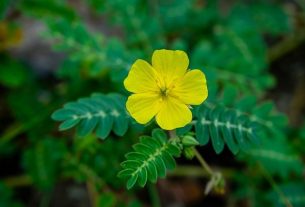Home remedies such as calendula and barbatimão compresses and oils such as copaiba and extra virgin, for example, are great options for naturally treating fissures and cracks in the nipples, which may appear during the breastfeeding period.
The healing, analgesic, anti-inflammatory and antiseptic effects of these plants provide relief from pain and burning, reduce discomfort when breastfeeding and accelerate skin regeneration, allowing cracks to close in less time.
Furthermore, they do not have any side effects, whether on the woman, the baby or the milk, which is why these medicinal plants can be used as a routine natural treatment, even if the fissures heal, in order to prevent them from opening again.

1. Barbatimão compress
Barbatimão is a healing, anti-inflammatory and antibacterial agent, which reduces swelling in the affected area and helps to close cracks that appear during breastfeeding. It also has an anesthetic effect, as it can relieve pain and burning minutes before breastfeeding begins. Check out other benefits of barbatimão.
Ingredients:
- 20 g of Barbatimão bark or leaves;
- 1 liter of water.
Preparation mode:
In 1 liter of boiling water add the Barbatimão peels or leaves and let them boil together for 10 minutes. After letting it warm, apply it to moistened cotton or gauze and leave it on the breasts for approximately 10 minutes.
2. Calendula compress
Calendula tea compress can be used to accelerate the healing of fissures and increase the production of collagen, essential for closing the wound and strengthening the skin, preventing it from opening again. In addition to having anti-inflammatory and antiseptic activity, they help relieve discomfort and pain. See the other benefits of calendula.
Ingredients:
- 2 g of calendula flowers;
- 50 ml of boiling water.
Preparation mode:
Mix the ingredients in a plastic container, cover and let rest for 15 minutes. After it warms up, moisten cotton wool in tea and leave it on the fissures until the next feeding.
3. Copaiba oil
Copaiba oil is also one of the natural healing agents that can be used to treat and prevent cracked nipples that appear during breastfeeding, in addition, it also has germicidal, antitumor and analgesic properties.
How to use: Apply a small amount of copaiba oil to the nipple containing the fissure and leave it to act for 40 minutes, after this time, clean it and leave the area dry.
4. Basil paste
Basil leaves can prevent possible infections and bleeding in the area where fissures exist, in addition to providing a calming effect by generating a sensation of coolness at the wound site.
Ingredients:
- 50 g of fresh basil.
Preparation mode:
Chop or crush the basil leaves until it turns into a moist paste. Then, place it in gauze and leave it on the injured nipple between feedings.
5. Extra virgin olive oil
Extra virgin olive oil has anti-inflammatory, antioxidant and moisturizing properties that accelerate the healing process and prevent new cracks from appearing, in addition to strengthening the skin where it was applied.
How to use: After breastfeeding, apply 3 drops of extra virgin olive oil directly to both nipples, even the one without fissures, and leave until the next feeding.

How to speed up healing
A natural option that can be used to treat and accelerate the healing of nipple fissures is breast milk, as it is moisturizing and healing, it treats existing cracks and prevents the appearance of new ones. Therefore, after breastfeeding, it is recommended to apply a little breast milk around the nipple and areola and let it dry naturally, without covering it. Furthermore, sunbathing in the morning, before 10 am and after 3 pm, can also help improve the cracks present.
If all the necessary care to heal the fissures has been taken, but there is no improvement, it is important to consult the obstetrician, so that guidance can be given according to the need and severity of the injury, so that the discomfort is reduced without causing damage to mother or baby.
What not to do
Avoid using alcohol, merthiolate, moisturizing creams or ointments that have not been recommended by the obstetrician, as this can harm the baby, as it comes into direct contact with the region and can leave residues that are difficult to remove during washing, in addition to the risk of clogging the nipple pores causing inflammation.
It is also important to remember that breast hygiene must be done before offering milk to the baby, as certain medicinal plants and natural oils can have a salty and slightly bitter taste to the baby, which can cause the milk to be rejected.
Bibliography
- CLINICS IN DERMATOLOGY. Virgin olive oil as a fundamental nutritional component and skin protector. 2009. Available at: <https://www.sciencedirect.com/science/article/abs/pii/S0738081X08000096>. Accessed on 02 Sep 2020
- WORLDVIEWS ON EVIDENCE-BASED NURSING . Application of Extra Virgin Olive Oil to Prevent Nipple Cracking in Lactating Women. 2015. Disponível em: <https://www.researchgate.net/publication/284164597_Application_of_Extra_Virgin_Olive_Oil_to_Prevent_Nipple_Cracking_in_Lactating_Women>. Acesso em 02 set 2020

Sign up for our newsletter and stay up to date with exclusive news
that can transform your routine!
Warning: Undefined array key "title" in /home/storelat/public_html/wp-content/plugins/link-whisper-premium/templates/frontend/related-posts.php on line 12
Warning: Undefined array key "title_tag" in /home/storelat/public_html/wp-content/plugins/link-whisper-premium/templates/frontend/related-posts.php on line 13



